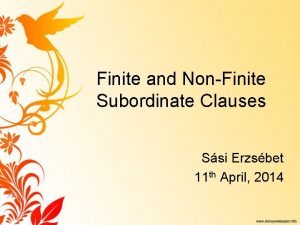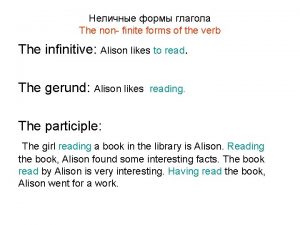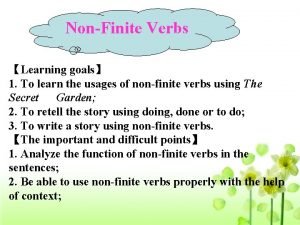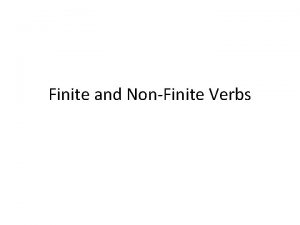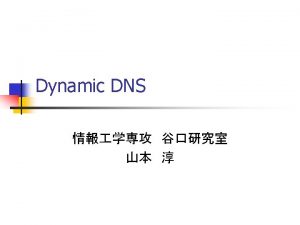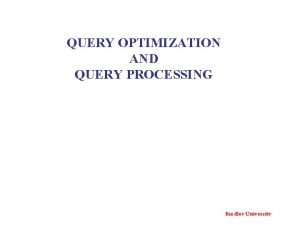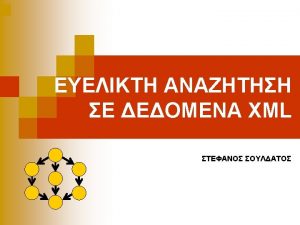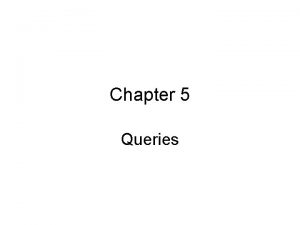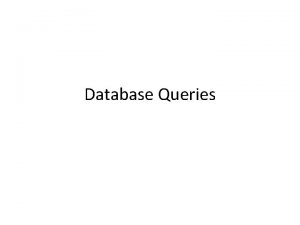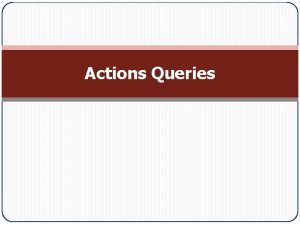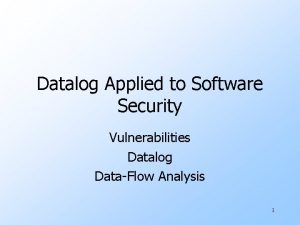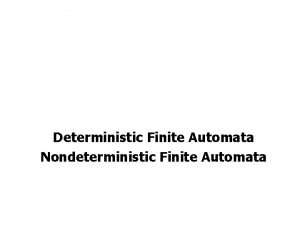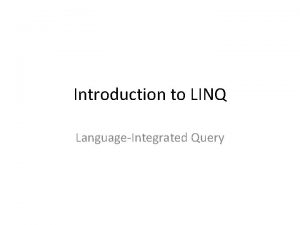4 Datalog Queries Datalog query a finite set












- Slides: 12

4. Datalog Queries Datalog query – a finite set of rules of the form: R 0(x 1, …, xk) : – R 1(x 1, 1, …, x 1, k 1), . . . , Rn(xn, 1, …, xn, kn) where each Ri is either an input or a defined relation name. including built-in relations such as +(x, y, z) which means x + y = z. (We normally use the latter syntax. ) head of the rule – R 0 body of the rule – R 1, …, Rn 1

Example: Find the SSN and the tax. Tax_Due(s, t) : – Taxrecord(s, w, i, c), Taxtable(inc, t), w+i+c = inc. Find the streets that can be reached from (x 0, y 0). Reach(n) : – Street(n, x 0, y 0). Reach(n) : – Reach(m), Street(m, x, y), Street(n, x, y). Find the time to travel from x to y. Travel(x, y, t) : – Go(x, 0, y, t). Travel(x, y, t) : – Travel(x, z, t 2), Go(z, t 2, y, t). 2

Example: Find town points covered by a radio station Covered(x 2, y 2) : – Broadcast(n, x, y), Town(t, x 2, y 2), Parameters(n, s, blat, blong), Parameters(t, s 2, tlat, tlong), x 2 = x + (tlat – blat), y 2 = y + (tlong – blong). 3

4. 2 Datalog with Sets Example: Hamiltonian Cycle Input: • Vertices(S) • Edge ({c 1}, {c 2}) • Start({c}) where S is a set of vertices if there is an edge from c 1 to c 2 where c is start city name Output: • Path ({c}, B) • Hamiltonian ({c}) if there is a path from c that uses all vertices except those in B. if there is a Hamiltonian path. 4

Base case – Path is a single vertex. All vertices except the start vertex is unvisited. Path(X 1, B) : – Vertices(A), Start(X 1), B = A X 1. Recursion – Path(X 1, B) : – Path(X 2, A), Edge(X 2, X 1), X 1 A, B = A X 1. a path to X 1 with B unvisited exists if there is a path to X 2 with A unvisited an edge from X 2 to X 1, which is unvisited, and B is A minus X 1 5

If there is a path from start to X 2 that visits all vertices and an edge from X 2 to start, then there is a Hamiltonian cycle. Hamiltonian(X 1) : – Path(X 2, ), Edge(X 2, X 1), Start(X 1). 6

4. 4 Datalog with Abstract Data Types Example: Streets(Name, Extent) where extent is a set of 2 D points. Let (x 0, y 0) be a start location. Express the reach relation: Reach(n) : – Street(n, Extent), {(x 0, y 0)} Extent. Reach(n) : – Reach(m), Street(m, S 1), Street(n, S 2), S 1 S 2 7

4. 5 Semantics Rule instantiation – substitution of variables by constants ⊢Q, I R(a 1, …. . ak) – R(a 1, …. ak) has a proof using query Q and input database I, iff • R represents input relation r and (a 1, …. ak) r , or • There is some rule and instantiation R(a 1, …, ak): –R 1(a 1, 1, …, a 1, k 1), …, Rn(an, 1, …, an, kn). where ⊢Q, I Ri(ai, 1, …, ai, ki) for each 1 i n. 8

Example: Reach(Vine) : – Street(Vine, 5, 2). Reach(Bear) : – Reach(Vine), Street(Vine, 5, 12), Street(Bear, 5, 12). Reach(Hare) : – Reach(Bear), Street(Bear, 8, 13), Street(Hare, 8, 13). 9

Example: By the input database (Figure 1. 2): Go(Omaha, 0, Lincoln, 60) Go(Lincoln, 60, Kansas_City, 210) Go(Kansas_City, 210, Des_Moines, 390) Go(Des_Moines, 390, Chicago, 990) We also have: Travel(Omaha, Lincoln, 60): - Go(Omaha, 0, Lincoln, 60) Travel(Omaha, Kansas_City, 210): - Travel(Omaha, Lincoln, 60), Go(Lincoln, 60, Kansas_City, 210). 10

11

Proof-based semantics – derived relations are the set of tuples that can be proven. Fixed point semantics – an interpretation of the derived relations such that nothing new can be proven. Least fixed point semantics – smallest possible FP semantics. Proof-based semantics = Least fixed point semantics 12
 Finite and non finite subordinate clauses
Finite and non finite subordinate clauses Non finite forms of the verb qayda
Non finite forms of the verb qayda Finite verb
Finite verb Learning objectives for finite and non finite verbs
Learning objectives for finite and non finite verbs Finite and non finite verb
Finite and non finite verb Total set awareness set consideration set
Total set awareness set consideration set Training set validation set test set
Training set validation set test set Iterative query vs recursive query
Iterative query vs recursive query Query tree and query graph
Query tree and query graph Query tree and query graph
Query tree and query graph Datalog
Datalog Datalog semantic web
Datalog semantic web Datalog tutorial
Datalog tutorial
